MOVIE REVIEW: AMERICAN PASTORAL
November 3, 2016
It has long been a running banter between myself and Ewan McGregor as to when he would move from in front of the camera to behind the lens. His response has consistently been, "When I find the right project." Well, the "right project" finally came along with the adaptation of Philip Roth's Pulitzer Prize-winning AMERICAN PASTORAL. Often described as a complex and challenging work, and rightly so, this 1997 Roth work is perhaps the hallmark of his prolific career. And while many of Roth's works have been adapted for the screen (most recent, "Indignation"), some with great success and some not so, it is that very complexity of AMERICAN PASTORAL that has been one of the reasons it has taken until now for it to be brought to life on the big screen. Proving to have a beautiful directorial eye skilled with visual storytelling and, thanks to a trimmed down, chronologically efficient script by John Romano that retains the emotional and historical depth and richness of Roth's work, McGregor now delivers an immersive and compelling work.
Not only directing AMERICAN PASTORAL but starring in it, McGregor sets the tone in front of and behind the camera as we explore the life of Seymour "Swede" Levov from post-World War II 1950's through the turbulent 1960's and into th 70's. Swede Levov is a legend in his native Newark, New Jersey. A first generation American very gentile-looking Jew, he is the son of glove manufacturer Lou Levov. Lou, a hard-working man who built a business from nothing into the success it became, has long fostered that ethic within Swede. Swede, however, took those life lessons and applied them to athletics where he was the star of every sports team in his high school. Capitalizing on the sticktuitiveness instilled in him by his father, after his stint in the Marine Corps, Swede set his sights on marrying shiksa princess Dawn, a former beauty queen and runner-up to Miss New Jersey. Easily sliding into the family business, Swede had the idyllic life; the American Dream was his. Successful business, beautiful wife and an adorable blonde-haired blue-eyed daughter named Merry.
As time marches on, we become intimately familiar with the Levov family and Swede's business. Dawn is still as beautiful as ever and appears ever the proper trophy wife, but devotes her time to raising cows on the family multi-acre spread. Merry suffers with a pronounced stutter that despite special tutoring and psychological counseling never seems to improve, thus creating a tacit rift in the mother-daughter relationship as Merry pales in comparison to her "perfect" mother. It also drives Swede to pay even more attention to his beloved daughter.
Smart as a whip, Merry is quick to pick up on emotions within the extended family unit as well as the Levov business; something which soon sets the stage for a cataclysmic event. With the advent of civil rights and the Vietnam War, Merry starts channeling her emotions into anti-extremist ideologies. Rage, which had been bubbling under the surface for years in the form of her stutter, erupts into radical conflicts with her parents as she enters those explosive teenaged years.
Moved by Angela Davis, the Black Panthers and the injustices she sees on television and in the news for years, Merry finally does channel her full energies into protesting the war, the government and the country when the local post office and mercantile in the quiet WASPy town of Rimrock blows up along with one of its notable citizens. Merry is the primary suspect, but no sooner does the bombing happen than Merry disappears. And Swede spirals ever downward.
Determined to find his daughter and reunite his now fractured family, i.e., restore the perfect image, Swede spares no expense and follows every lead long after the police and the FBI have given up searching. He spends night after night sitting at the train station just hoping to see his daughter appear. And with every waking moment he spends on finding Merry, Dawn slips further and further away until the point of never wanting to see or hear of Merry again, and finding herself in a mental institution. But something even darker is happening to Swede as he starts to relive and question every moment of his life, trying to find the moment, the event, that turned his daughter into a wanted terrorist.
Screenwriter John Romano keenly retains the anti-extremist ideologies of the Roth novel and together with McGregor's vision, are kept at the forefront of the storyline via Dawn's mental state, Merry's obsession with anti-everything and her fundamental conflict of self, and Swede's obsession with Merry. Creating a straightforward chronology as opposed to the continual back and forth within the book, Romano, frames the film with Swede's 45th high school reunion with the story unfolding through Nathan Zuckerman who serves essentially as our narrator. Zuckerman, who Roth fans will recognize as a frequent alter-ego for Roth himself, meets up with Swede's brother Jerry at the reunion who starts to tell the tale of what has happened over the past decades. As opposed to the novel where much of the exposition is through Zuckerman, here the exposition is the film itself, the visuals, the dialogue, the performances. And what performances!
The real standouts in AMERICAN PASTORAL come in the form of Dakota Fanning who comes into her own as a mature actress with her portrayal of Merry. Running the gambit of emotion from overly anxious to volatile and explosive to extremely calm thanks to a shift in Merry's belief system to that of Jain, Fanning is revelatory, commanding the screen at every turn. Her presence is unshakeable.
Hand in hand with Fanning's performance is that of Hannah Nordberg who plays the already volatile 12-year old Merry.
Joining Fanning is Valorie Curry. Curry plays Rita Cohen, a fellow activist who is allegedly serving as a go-between for Swede and Merry. A white Angela Davis, right down to curly back hair and Davis' patented head scarf, Curry is energetic and personifies a "power to the people" hippie spirit and radicalism.
Joyous is Peter Riegert who, as Lou Levov, is the personification of the post-WWII immigrant era on the East Coast, and particularly New Jersey. Devoted family man, and scrupulous businessman, Lou Levov is the one character that never suffers with self-doubt or an identity crisis. And having a veteran like Riegert, long known for his role in "Animal House", as the patriarch, provides a casting depth and authenticity.
One of the most indelible performances and by extension, relationship, in AMERICAN PASTORAL comes from Uzo Aduba as Levov employee and Swede's right-hand, Vicky. A critical component to who Swede is, or believes he is, is the dynamic between the African-American Vicky and Swede; particularly during the 1967 Newark riots. The scenes between Aduba and McGregor are not only substantive and meaty, but are filled with subtlety and respect, while satisfying a polarizing aspect of the 60's.
While a good portion of the film films Jennifer Connelly as the dutiful wife Dawn, as the Levov family spirals out of control thanks to Merry, when Dawn finally crashes and burns with a complete mental breakdown, Connelly soars. Talk about acting chops. She mesmerizes. It is impossible to look away from her emotional nuance.
And then there's Ewan McGregor as Swede Levov. Charismatic, engaging, gorgeous to look at, there's no doubt about Mcgregor's acting skills and his ability to wear multiple hats with this production. The emotional fortitude he brings to Swede often feels like being punched in the gut with a sledgehammer.
David Straithern serves the role of Nathan Zuckerman well while Rupert Evans handily fills the shoes of Jerry Levov.
Populating the film with visual and auditory imagery reflective of each era, while many may believe it to be superficial window dressing, as the film progresses and again on reflection, each bit of minutiae by McGregor, production designer Daniel Clancy and costumer Lindsay McKay, has been subconsciously informing the audience. Period posters and news footage are prominent and effective with the setting of the cultural stage and telling of Merry's story and her break from normalcy. Notable are McKay's costumes, especially those for McGregor as the fabrications themselves show the passage of time while color selections address the overall emotional tone at specific moments.
While relying on the expertise of producers Tom Rosenberg and Gary Lucchesi for many artisans and department heads involved in AMERICAN PASTORAL, it is McGregor who brought cinematographer Martin Ruhe to the table. With exemplary lighting and framing, Ruhe helps define the eras and the emotional tonal bandwidth; creating a bright sunlit tone for the first half of the film serving as a metaphor which defines the clarity of the world and Swede's American Dream, but then moving into a second half contrast with inky blue-blacks reflecting the shadows and doubts of a world in turmoil and the questioning self-doubts of Swede. Stunning cinematographic work by Ruhe.
Shot on location in and around Pittsburgh serving as 1950's and 60's Newark, we are steeped in the architecture and landscapes of the era. Knowing the Newark region fairly well myself during that time period, even I was doing a double take.
Beauteous is Alexandre Desplat's score. Melodic, subtle and haunting; just like AMERICAN PASTORAL.
Directed by Ewan McGregor
Written by John Romano based on the novel by Philip Roth
Cast: Ewan McGregor, Jennifer Connelly, Dakota Fanning, Uzo Aduba, Peter Riegert, Valorie Curry, David Straithern, Rupert Evans

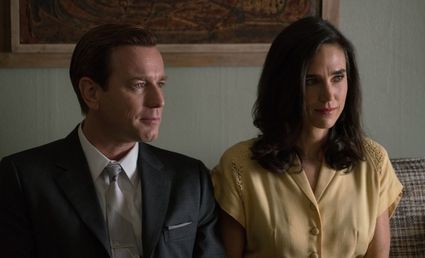
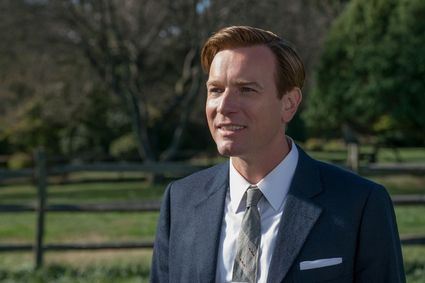
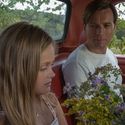

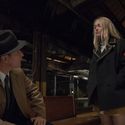
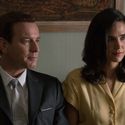


















Reader Comments(0)